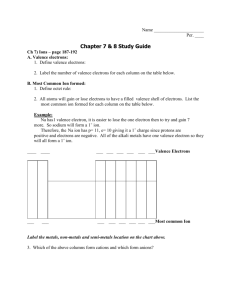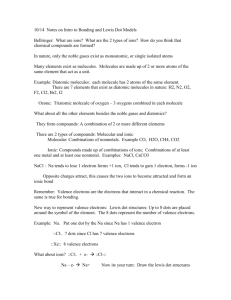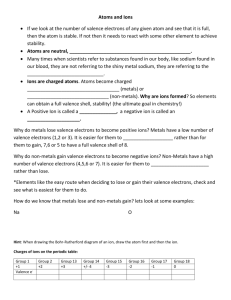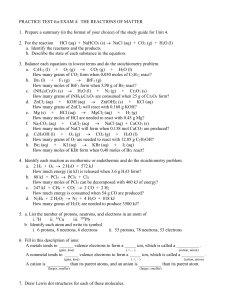Science 9: Unit 3 Review Worksheet #1. I can define valence
advertisement
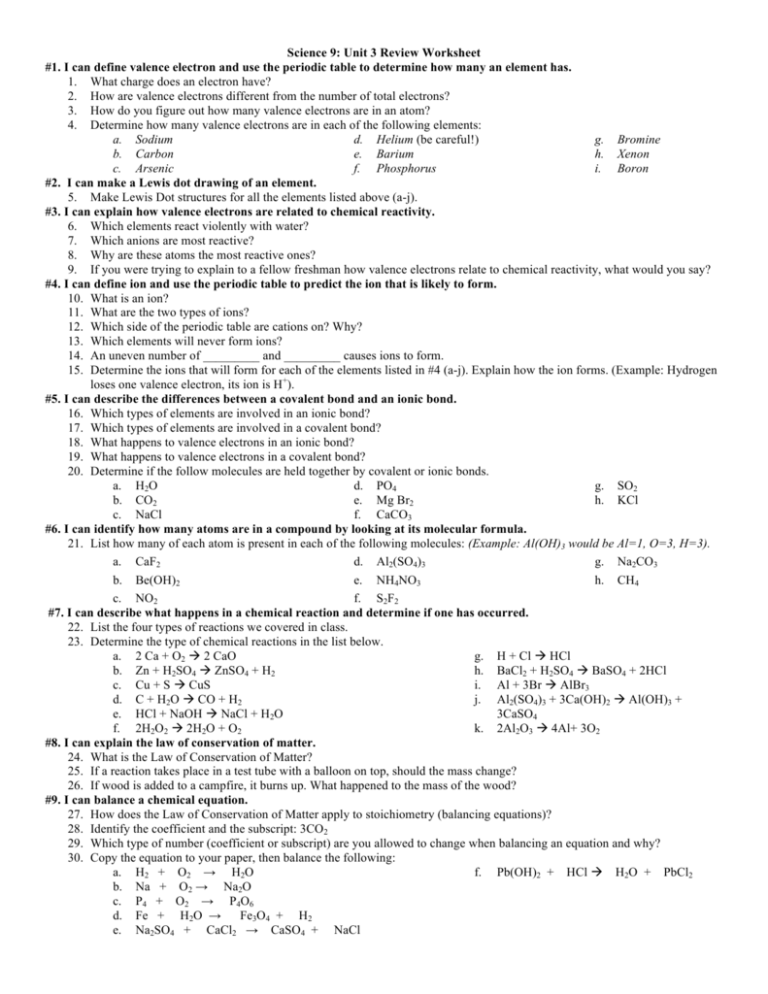
Science 9: Unit 3 Review Worksheet #1. I can define valence electron and use the periodic table to determine how many an element has. 1. What charge does an electron have? 2. How are valence electrons different from the number of total electrons? 3. How do you figure out how many valence electrons are in an atom? 4. Determine how many valence electrons are in each of the following elements: a. Sodium d. Helium (be careful!) g. Bromine b. Carbon e. Barium h. Xenon c. Arsenic f. Phosphorus i. Boron #2. I can make a Lewis dot drawing of an element. 5. Make Lewis Dot structures for all the elements listed above (a-j). #3. I can explain how valence electrons are related to chemical reactivity. 6. Which elements react violently with water? 7. Which anions are most reactive? 8. Why are these atoms the most reactive ones? 9. If you were trying to explain to a fellow freshman how valence electrons relate to chemical reactivity, what would you say? #4. I can define ion and use the periodic table to predict the ion that is likely to form. 10. What is an ion? 11. What are the two types of ions? 12. Which side of the periodic table are cations on? Why? 13. Which elements will never form ions? 14. An uneven number of _________ and _________ causes ions to form. 15. Determine the ions that will form for each of the elements listed in #4 (a-j). Explain how the ion forms. (Example: Hydrogen loses one valence electron, its ion is H+). #5. I can describe the differences between a covalent bond and an ionic bond. 16. Which types of elements are involved in an ionic bond? 17. Which types of elements are involved in a covalent bond? 18. What happens to valence electrons in an ionic bond? 19. What happens to valence electrons in a covalent bond? 20. Determine if the follow molecules are held together by covalent or ionic bonds. a. H2O d. PO4 g. SO2 b. CO2 e. Mg Br2 h. KCl c. NaCl f. CaCO3 #6. I can identify how many atoms are in a compound by looking at its molecular formula. 21. List how many of each atom is present in each of the following molecules: (Example: Al(OH)3 would be Al=1, O=3, H=3). a. CaF2 d. Al2(SO4)3 g. Na2CO3 b. Be(OH)2 e. NH4NO3 h. CH4 c. NO2 f. S2F2 #7. I can describe what happens in a chemical reaction and determine if one has occurred. 22. List the four types of reactions we covered in class. 23. Determine the type of chemical reactions in the list below. a. 2 Ca + O2 2 CaO g. H + Cl HCl b. Zn + H2SO4 ZnSO4 + H2 h. BaCl2 + H2SO4 BaSO4 + 2HCl c. Cu + S CuS i. Al + 3Br AlBr3 d. C + H2O CO + H2 j. Al2(SO4)3 + 3Ca(OH)2 Al(OH)3 + e. HCl + NaOH NaCl + H2O 3CaSO4 f. 2H2O2 2H2O + O2 k. 2Al2O3 4Al+ 3O2 #8. I can explain the law of conservation of matter. 24. What is the Law of Conservation of Matter? 25. If a reaction takes place in a test tube with a balloon on top, should the mass change? 26. If wood is added to a campfire, it burns up. What happened to the mass of the wood? #9. I can balance a chemical equation. 27. How does the Law of Conservation of Matter apply to stoichiometry (balancing equations)? 28. Identify the coefficient and the subscript: 3CO2 29. Which type of number (coefficient or subscript) are you allowed to change when balancing an equation and why? 30. Copy the equation to your paper, then balance the following: a. H2 + O2 → H2O f. Pb(OH)2 + HCl H2O + PbCl2 b. Na + O2 → Na2O c. P4 + O2 → P4O6 d. Fe + H2O → Fe3O4 + H2 e. Na2SO4 + CaCl2 → CaSO4 + NaCl
